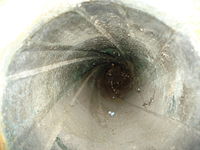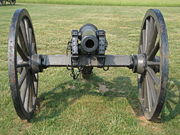| Chimney Rock had been quiet,
almost too quiet in the time since the last big mineral
cycle caused the town to boom, with violent results. But now, the easy
money was gone from the town and gone too were most of the bad men and
wild women that bring a colorful, if sometimes raucous energy to a town.
But like the storm clouds building up in the mountains
there was a change building in the town. An old miner, exploring his played
out claim had chanced upon some strange symbols cut into freshly exposed
rock, a box with a cross above it and a triangle in a circle. With further
investigation the old miner found a small strong box with an old pistol
with a J carved into the grips, a quantity of gold and silver coins, a
journal and some strangely marked maps.
The old miner was cagey but he couldn't read. So he hid
most of the gold and most of the maps and took the pistol and the journal
back to town to get
someone to read from it in hopes of finding out more
about this strange find. Little did the old miner suspect that the journal
he had found belonged to none other than Jesse James and the markers and
the maps held the keys to a Civil War treasure, hidden in the hills by
members of the Knights of the Golden Circle, a Southern group who were
known to have hidden money and arms throughout the South and Southwest
in order for the Confederacy to take over Northern Mexico, and later to
keep the hopes of the South alive in the waning days of the conflict with
the North.
The only person the old miner knew could read in the town
of Chimney rock was Thomas Francis Shelby, a barber and dentist from Missouri
who had fought in the civil war and who knew the meaning of the symbols
and the importance of the journal as soon as the Old miner showed them
to him. Convincing the old man to show him the symbols T. F. Shelby accompanied
the miner to his old claim and upon seeing the marks in the rocks shot
the old man in the back, leaving him to die in the hills.
While Shelby rode back to Chimney Rock, the old miner,
tougher than he looked dragged himself up toward his old cabin. Before
getting there he was
found by a passing stranger and the old man told him
his story and knowing he was about to die, trusted him with the secret
of the maps and asked the
stranger to make sure that he was buried proper and that
the money, if there was any was sent to his daughter he had left behind
back in St. Louis.
The stranger promised the old miner that his wishes would
be met and after he buried him and located the maps, the stranger went
down to town to serve
justice.
Meanwhile, Shelby had been burning up the telegraph wires,
contacting relatives and shadowy men who begin the trip to Chimney Rock
and the promise
of treasure, and violence. Once again it seemed that
Chimney Rock was to be the site of a clash of wills and witness to the
flash, smoke and thunder of
a battle. |
| Rifling from Wikipedia
Rifling refers to the helix-shaped
pattern in the barrel of a firearm, which imparts a spin to a projectile
around its long axis. This spin serves to gyroscopically stabilize the
projectile, improving its aerodynamic stability and accuracy.
Rifling is described by its twist
rate, which indicates the distance the bullet must travel to complete one
full revolution, such as "1 turn in 10 inches" (1:10 inches), or "1 turn
in 30 cm" (1:30 cm). A shorter distance indicates a "faster" twist, meaning
that for a given velocity the projectile will be rotating at a higher spin
rate.
The length of a projectile determines
the twist rate needed to stabilize it - barrels intended for short, large-diameter
projectiles like spherical lead balls require a very low twist rate, such
as 1 turn in 48 inches (122 cm). Barrels intended for long, small-diameter
bullets, such as the ultra-low-drag, 80-grain 0.224 inch bullets (5.2 g,
5.56 mm), use twist rates of 1 turn in 8 inches (20 cm) or faster.
In some cases, rifling will have
twist rates that increases down the length of the barrel, called a gain
twist; a twist rate that decreases from breech to muzzle is undesirable,
as it cannot reliably stabilize the bullet as it travels down the bore.
Extremely long projectiles such as flechettes may require impractically
high twist rates; these projectiles must be inherently stable, and are
often fired from a smoothbore barrel.

Rifling of a Canon de 75 modèle 1897 |

Rifling in a .35 Remington microgroove rifled barrel |
Manufacture
| Most rifling is created by either:
* cutting one
groove at a time with a machine tool (cut rifling or single point cut rifling);
* cutting all
grooves in one pass with a special progressive broaching bit (broached
rifling);
* pressing all
grooves at once with a tool called a "button" that is pushed or pulled
down the barrel
(button rifling);
* forging the
barrel over a mandrel containing a reverse image of the rifling, and often
the chamber as well (hammer forging);
* flow forming
the barrel preform over a mandrel containing a reverse image of the rifling
(rifling by flow forming) |

Rifling in a French 19th century
cannon |
The grooves are the spaces that are
cut out, and the resulting ridges are called "lands". These lands and grooves
can vary in number, depth, shape, direction of twist ("right" or "left"),
and "twist rate" (turns per unit of barrel length). The spin imparted by
rifling significantly improves the stability of the projectile, improving
both range and accuracy. Typically rifling is a constant rate down the
barrel, usually measured by the length of travel required to produce a
single turn. Occasionally firearms are encountered with a gain twist, where
the rate of spin increases from chamber to muzzle. While intentional gain
twists are rare, due to manufacturing variance, a slight gain twist is
in fact fairly common. Since a reduction in twist rate is very detrimental
to accuracy, gunsmiths who are machining a new barrel from a rifled blank
will often measure the twist carefully so they may put the faster rate,
no matter how minute the difference is, at the muzzle end (see internal
ballistics for more information on accuracy and bore characteristics).
Construction and operation.
| A barrel of circular cross-section
is not capable of imparting a spin to a projectile, so a rifled barrel
has a non-circular cross-section. Typically the rifled barrel contains
one or more grooves that run down its length, giving it a cross-section
resembling a gear, though it can also take the shape of a polygon, usually
with rounded corners. Since the barrel is not circular in cross-section,
it cannot be accurately described with a single diameter. Rifled bores
may be described by the bore diameter (the diameter across the lands or
high points in the rifling), or by groove diameter (the diameter across
the grooves or low points in the rifling.) Differences in naming conventions
for cartridges can cause confusion; for example, the .303 British is actually
slightly larger in diameter than the .308 Winchester, because the ".303"
refers to the bore diameter in inches, while the ".308" refers to the groove
diameter in inches (7.70 mm and 7.82 mm, respectively.) |

Conventional rifling (left) and
polygonal rifling (right)
More on Polygonal Rifling to follow
this article |
Despite differences in form, the common
goal of rifling is to deliver the projectile accurately to the target.
In addition to imparting the spin to the bullet, the barrel must hold the
projectile securely and concentrically as it travels down the barrel. This
requires that the rifling meet a number of tasks:[4]
1. It must be sized
so that the projectile will swage or obturate upon firing to fill the bore.
2. The diameter should
be consistent, and must not increase towards the muzzle.
3. The rifling should
be consistent down the length of the bore, without changes in cross-section,
such as variations in groove width or spacing.
4. It should be smooth,
with no scratches lying perpendicular to the bore, so it does not abrade
material from the projectile.
5. The chamber and
crown must smoothly transition the projectile into and out of the rifling.
When the projectile is swaged into
the rifling, it takes on a mirror image of the rifing, as the lands push
into the projectile in a process called engraving. Engraving takes on not
only the major features of the bore, such as the lands and grooves, but
also minor features, like scratches and tool marks. The relationship between
the bore characteristics and the engraving on the projectile are often
used in forensic ballistics.
Fitting the projectile to the bore
The original firearms were loaded
from the muzzle by forcing a ball from the muzzle to the breech. Whether
using a rifled or smooth bore, a good fit was needed to seal the bore and
provide the best possible accuracy from the gun. To ease the force required
to load the projectile, these early guns used an undersized ball, and a
patch made of cloth, paper, or leather to fill the windage (the gap between
the ball and the walls of the bore.) The patch provided some degree of
sealing, kept the ball seated on the charge of black powder, and kept the
ball concentric to the bore. In rifled barrels, the patch also provided
a means to transfer the spin from the rifling to the bullet, as the patch
is engraved rather than the ball. Until the advent of the hollow-base Minié
ball, which obturates upon firing to seal the bore and engage the rifling,
the patch provided the best means of getting the projectile to engage the
rifling.
In breech-loading firearms, the
task of seating the projectile into the rifling is handled by the throat
of the chamber. Next is the freebore, which is the portion of the throat
down which the projectile travels before the rifling starts. The last section
of the throat is the throat angle, where the throat transitions into the
rifled barrel.
The throat is usually sized slightly
larger than the projectile, so the loaded cartridge can be inserted and
removed easily, but the throat should be as close as practical to the groove
diameter of the barrel. Upon firing, the projectile expands under the pressure
from the chamber, and obturates to fit the throat. The bullet then travels
down the throat and engages the rifling, where it is engraved, and begins
to spin. Engraving the projectile requires a significant amount of force,
and in some firearms there is a significant amount of freebore, which helps
keep chamber pressures low by allowing the propellant gases to expand before
being required to engrave the projectile. Best accuracy, however, is typically
provided with a minimum of freebore, maximizing the changes that the projectile
will enter the rifling without distortion.
Twist rate
For best performance, the barrel
should have a twist rate sufficient to stabilize any bullet that it would
reasonably be expected to fire, but not significantly more. Large diameter
bullets provide more stability, as the larger radius provides more gyroscopic
inertia, while long bullets are harder to stabilize, as they tend to be
very backheavy and the aerodynamic pressures have a longer "lever" to act
on. The slowest twist rates are found in muzzleloading firearms meant to
fire a round ball; these will have twist rates as low as 1 in 60 inches
(1,500 mm), or slightly longer, although for a typical multi-purpose muzzleloader
rifle, a twist rate of 1 in 48 inches (1,200 mm) is very common. The M16A2
rifle, which is designed to fire the SS109 bullet, has a 1 in 7-inch (180
mm) twist. Civilian AR-15 rifles are commonly found with 1 in 12 inches
(300 mm) for older rifles and 1 in 9 inches (230 mm) for most newer rifles,
although some are made with 1 in 7 inches (180 mm) twist rates, the same
as used for the M16. Rifles, which generally fire longer, smaller diameter
bullets, will in general have higher twist rates than handguns, which fire
shorter, larger diameter bullets.
George Greenhill, a mathematician
at Emmanuel College, Cambridge, UK, developed a rule of thumb for use in
calculating twist rates for a given lead-core bullet. The formula, named
the Greenhill Formula in his honour, is:

where:
* C = 150 (use 180 for muzzle velocities
higher than 2,800 f/s)
* D = bullet's diameter in inches
* L = bullet's length in inches
* SG = bullet's specific gravity (10.9
for lead-core bullets, which cancels out the second half of the equation)
The original value of C was 150, which yields a twist
rate in inches per turn, when given the diameter D and the length L of
the bullet in inches. This works to velocities of about 840 m/s (2800 ft/s);
above those velocities, a C of 180 should be used. For instance, with a
velocity of 600 m/s (2000 ft/s), a diameter of 0.5 inches (13 mm) and a
length of 1.5 inches (38 mm), the Greenhill formula would give a value
of 30, which means 1 turn in 30 inches (760 mm).
| If an insufficient twist rate is used, the bullet will
begin to yaw and then tumble; this is usually seen as "keyholing", where
bullets leave elongated holes in the target as they strike at an angle.
Once the bullet starts to yaw, any hope of accuracy is lost, as the bullet
will begin to veer off in random directions as it precesses.
Conversely, too-high a rate of twist can also cause problems.
The excessive twist can cause accelerated barrel wear, and also induce
a very high spin rate which can cause high-velocity projectiles to disintegrate
in flight. A higher twist than needed can also cause more subtle problems
with accuracy: Any inconsistency within the bullet, such as a void that
causes an unequal distribution of mass, may be magnified by the spin. Undersized
bullets also have problems, as they may not enter the rifling exactly concentric
and coaxial to the bore, and excess twist will exacerbate the accuracy
problems this causes. Lastly, excessive spinning causes a reduction in
the lateral kinetic energy of a projectile, thereby reducing its destructive
power (the energy instead becomes rotational kinetic energy). |

A Parrott rifle, used by both Confederate and Union forces
in the American Civil War |
Recent developments
The grooves most commonly used in modern rifling have
fairly sharp edges. More recently, polygonal rifling, a throwback to the
earliest types of rifling, has become popular, especially in handguns.
Polygonal barrels tend to have longer service lives because the reduction
of the sharp edges of the land reduces erosion of the barrel. Supporters
of polygonal rifling also claim higher velocities and greater accuracy.
Polygonal rifling is currently seen on pistols from Heckler & Koch,
Glock and Kahr Arms, as well as the Desert Eagle.
For tanks and artillery pieces, the extended range, full
bore concept developed by Gerald Bull for the GC-45 howitzer reverses the
normal rifling idea by using a shell with small fins that ride in the grooves,
as opposed to using a slightly oversized projectile which is forced into
the grooves. Such guns have achieved significant increases in muzzle velocity
and range. Examples include the South African G5 and the German PzH 2000.
|
| Polygonal rifling from Wikipedia
Polygonal rifling is a type of rifling
wherein the traditional lands and grooves are replaced by "hills and valleys"
in a rounded polygonal pattern, usually a hexagon.

Conventional eight groove rifling on the left, and octagonal
polygonal rifling on the right |
History
While polygonal rifling has been
around since the earliest days of rifled barrels, it had faded out of use
by the time of the early cordite cartridges. The last common rifle to use
polygonal rifling was the Lee-Metford rifle, named after the Metford rifling,
a 7 sided polygonal type rifling. The switch to cordite from black powder
proved too much for the shallow rifling in the relatively soft barrels
of the time, and the Lee-Metford became the Lee-Enfield when the Metford
rifling was dropped. Heckler & Koch was the first manufacturer to begin
using polygonal rifling in modern arms. Companies that utilize this method
today include Heckler & Koch, Glock, Magnum Research, Noveske Rifleworks
and Kahr Arms. Polygonal rifling is usually only found in pistol barrels,
and is less common in rifles, However some extremely high end rifles like
the PSG-1 use polygonal bores.
The term "polygonal rifling" is
fairly general, and different manufacturers employ varying polygonal rifling
profiles.
Advantages
A number of advantages are claimed
by the supporters of polygonal rifling. These include:
* Higher velocities
due to reduced friction of the bullet in the barrel, as the polygonal rifling
has less surface area than the lands and grooves of a traditionally rifled
barrel
* Less bullet
deformation, resulting in reduced drag on the bullet which helps to increase
range and accuracy
* Increased
barrel life and reduced buildup of copper or lead within the barrel
However, precision target pistols
such as those used in bullseye and IHMSA almost universally use traditional
rifling, as do target rifles. The debate among target shooters is almost
always one of cut vs. button rifled barrels, as traditional rifling is
dominant. Polygonal rifled barrels are used competitively in pistol action
shooting, such as IDPA and IPSC competitions.
Part of the difference may be that
most polygonal rifling is produced by hammer forging the barrel around
a mandrel containing a reverse impression of the rifling. Hammer forging
machines are tremendously expensive, far out of the reach of custom gunsmiths
(unless they buy pre-rifled blanks), and so are generally only used for
production barrels by large companies. The main advantage of a hammer forging
process is that it can rifle, chamber, and contour a bored barrel blank
in one step. First applied to gun barrel rifling in Germany in 1939, hammer
forging has remained popular in Europe, but was only later used by gunmakers
in the United States. The hammer forging process produces large amounts
of stress in the barrel that must be relieved by careful heat treatment,
a process that is less necessary in a traditionally cut or button rifled
barrel. Due to the potential for residual stress causing accuracy problems,
precision shooters tend to avoid hammer forged barrels, and this limits
them in the type of available rifling.
Lead bullets and polygonal rifling
The manufacturer Glock advises against
using lead bullets (meaning bullets not covered by a copper jacket) in
their polygonally rifled barrels, which has led to a widespread belief
that polygonal rifling is not compatible with lead bullets. Noted firearms
expert and barrel maker, the late Gale McMillan, has also commented that
lead bullets and polygonal rifling are not a good mix. However, since neither
H&K nor Kahr recommend against lead bullets in their polygonal rifled
barrels, it is probable that there is an additional factor involved in
Glock's warning. One explanation is that Glock barrels have a fairly sharp
transition between the chamber and the rifling, and this area is prone
to lead buildup if lead bullets are used. This buildup may result in failures
to fully return to battery, allowing the gun to fire with the case not
fully supported by the chamber, leading to a potentially dangerous case
failure. The other explanation is that Glock's barrels may be more prone
than normal to leading, which is the buildup of lead in the bore that happens
in nearly all firearms firing high velocity lead bullets. This lead buildup
must be cleaned out regularly, or the barrel can become constricted and
result in higher than normal pressures.
|